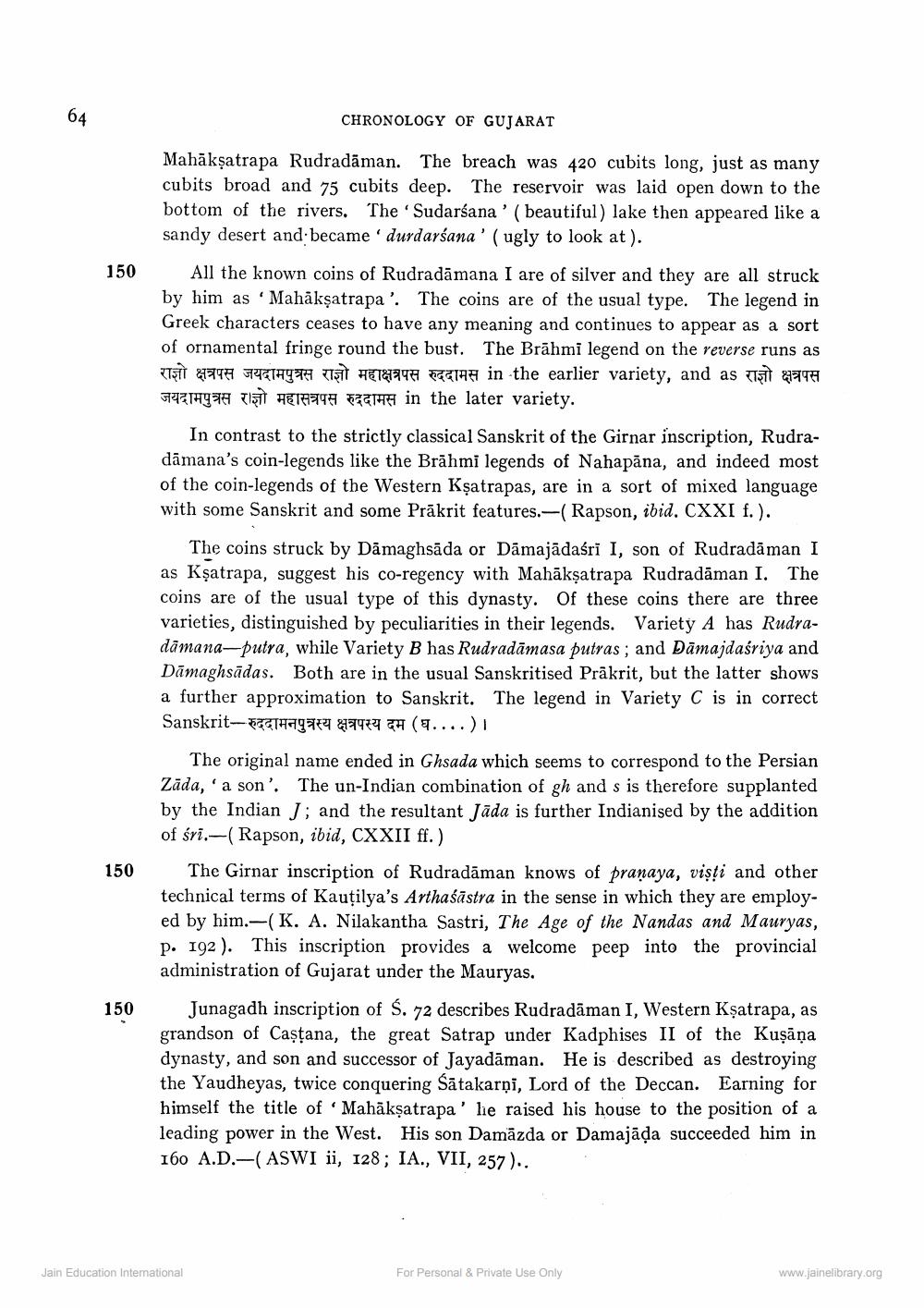________________
CHRONOLOGY OF GUJARAT
Mahākşatrapa Rudradāman. The breach was 420 cubits long, just as many cubits broad and 75 cubits deep. The reservoir was laid open down to the bottom of the rivers. The 'Sudarśana' (beautiful) lake then appeared like a sandy desert and became 'durdarśana' (ugly to look at).
150
All the known coins of Rudradāmana I are of silver and they are all struck by him as Mahākṣatrapa'. The coins are of the usual type. The legend in Greek characters ceases to have any meaning and continues to appear as a sort of ornamental fringe round the bust. The Brāhmi legend on the reverse runs as 27571 794 ETHYTTET HET4794 GG1h in the earlier variety, and as T 478 9427TH TITT HEIFH FR in the later variety.
In contrast to the strictly classical Sanskrit of the Girnar inscription, Rudradāmana's coin-legends like the Brāhmi legends of Nahapāna, and indeed most of the coin-legends of the Western Kşatrapas, are in a sort of mixed language with some Sanskrit and some Prākrit features.-(Rapson, ibid. CXXI f.).
The coins struck by Dāmaghsāda or Dāmajādaśrī I, son of Rudradāman I as Kșatrapa, suggest his co-regency with Mahākṣatrapa Rudradāman I. The coins are of the usual type of this dynasty. Of these coins there are three varieties, distinguished by peculiarities in their legends. Variety A has Rudradāmana-putra, while Variety B has Rudradāmasa putras; and Dāmajdasriya and Dāmaghsādas. Both are in the usual Sanskritised Prākrit, but the latter shows a further approximation to Sanskrit. The legend in Variety C is in correct Sanskrit-5761974 99979 CH (9....)
The original name ended in Ghsada which seems to correspond to the Persian Zāda, 'a son'. The un-Indian combination of gh and s is therefore supplanted by the Indian J; and the resultant Jāda is further Indianised by the addition of śrī.-(Rapson, ibid, CXXII ff.)
The Girnar inscription of Rudradāman knows of pranaya, visti and other technical terms of Kautilya's Arthaśāstra in the sense in which they are employed by him.-(K. A. Nilakantha Sastri, The Age of the Nandas and Mauryas, p. 192). This inscription provides a welcome peep into the provincial administration of Gujarat under the Mauryas.
Junagadh inscription of Ś. 72 describes Rudradāman I, Western Kşatrapa, as grandson of Caștana, the great Satrap under Kadphises II of the Kuşāņa dynasty, and son and successor of Jayadāman. He is described as destroying the Yaudheyas, twice conquering Sātakarņi, Lord of the Deccan. Earning for himself the title of Mahākṣatrapa' le raised his house to the position of a leading power in the West. His son Damāzda or Damajāļa succeeded him in 160 A.D.-(ASWI ii, 128; IA., VII, 257)..
150
150
Jain Education Intemational
For Personal & Private Use Only
www.jainelibrary.org




